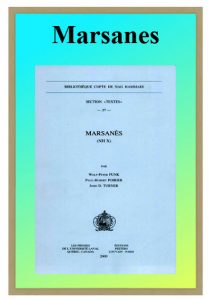Information on Marsanes
BIRGER A. PEARSON WRITES, “The prophet Marsanes is known from two other sources. He, together with another prophet named Nicotheus (or Nikotheos), is named in the ‘Untitled Text’ of the Bruce Codex (ch. 7). As noted above, Nicotheus is also mentioned in Porphyry’s Life of Plotinus (ch. 16). In the Bruce Codex, Marsanes and Nicotheus are said to be ‘great ones’ who have seen heavenly verities and revealed them to others. Epiphanius, in his discussion of the Archontics, mentions two prophets honored by them, Martiades and Marsianos, who had been snatched up to the heavens and had come down after three days (Panarion 40.7.6). (‘Marsianos’ and ‘Marsanes’ are two different ways of rendering in Greek a name of Syriac origin.) Visionary ascent is certainly a prominent feature of what remains of the Nag Hammadi tractate Marsanes. In this tractate Marsanes gives advanced instruction to a group of his followers who have already been initiated into gnosis. The author of the tractate may be the Gnostic prophet Marsanes himself; alternatively he may be an otherwise unknown teacher who claims to be writing in the name of the prophet Marsanes. Marsanes reflects a good deal of the Platonist school tradition that we have seen in Steles Seth, Zostrianos, and Allogenes.” (Ancient Gnosticism, pp. 92-93)
John D. Turner writes, “All scholars who have had occasion to comment on Marsanes in relation to other Sethian literature have called attention to its unique postulation of a new supreme principle, the Unknown Silent One, which transcends the Invisible Spirit, who is otherwise the supreme principle of all the other Sethian treatises. This modification of Sethian theology is parallel to a similar phenomenon that occurs in Iamblichus (cf. Damascius On First Principles 1.21,11-14; 25,21-22) and his disciple Theodore of Asine (Proclus Commentary on Plato’s Timaeus 2,274,10-20), who placed an ineffable One absolutely unrelated to anything else at the summit of all reality – including Plotinus’s supreme One, which was at least ‘present to’ subsequent reality. Of course, at least in the case of Marsanes and Theodore, this supreme One nevertheless has some relation to its inferiors, since for Theodore, the ‘second One’ was the aspiration (‘breathing’), self-contact, and intelligibility of the first One, and for Marsanes, the Invisible Spirit (which ‘has no breath,’ 15,1-4; 15,29-16,2) eems to share both the silence and the activity of the Unknown Silent One. On these grounds as well as the presence of the prophet’s name in the Bruce Codex, one might date Marsanes to the late third or early fourth century, contemporary with Iamblichus and Theodore.” (The Nag Hammadi Scriptures, p. 631)
